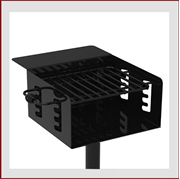Public spaces, such as parks, recreational areas, and urban plazas, play a crucial role in fostering community engagement and providing citizens with areas to relax and connect with nature. One common feature in these spaces is the use of commercial picnic tables. While these tables contribute to the convenience and social atmosphere of public areas, it is essential to examine their environmental impact. This article delves into the environmental considerations associated with the production, use, and disposal of commercial picnic tables.
Material Selection
Commercial picnic tables are typically made from various materials, including wood, metal, and plastic. The choice of material significantly influences the environmental footprint of the tables. Wooden tables sourced from sustainably managed forests can be a more environmentally friendly option, promoting responsible forestry practices. In contrast, tables made from non-renewable materials or those contributing to deforestation may have a more adverse impact.

Manufacturing Processes
The manufacturing processes involved in producing commercial picnic tables can contribute to environmental pollution and resource depletion. Facilities that prioritize energy efficiency, waste reduction, and sustainable sourcing help mitigate the negative effects. Choosing manufacturers with environmentally conscious practices can lead to a more eco-friendly selection of picnic tables.
Longevity and Durability
The lifespan of commercial picnic tables is a crucial factor in determining their overall environmental impact. Durable and long-lasting tables require fewer replacements, reducing the demand for new materials and minimizing waste. Tables made from materials resistant to weathering and wear contribute positively to sustainability.
Transportation and Distribution
The transportation of commercial picnic tables from manufacturing facilities to their final destinations has environmental implications. Locally sourced tables or those produced near their point of use can help minimize carbon emissions associated with long-distance transportation. Additionally, efficient distribution methods and packaging practices can further reduce the environmental impact.
End-of-Life Considerations
Proper disposal and recycling of commercial picnic tables are essential aspects of their environmental impact. Tables made from recyclable materials can be repurposed, reducing the burden on landfills. Wood tables, in particular, can be recycled or composted, contributing to a more sustainable end-of-life cycle.
Maintenance Practices
Regular maintenance of commercial picnic tables can extend their lifespan and reduce the need for replacements. Environmentally friendly cleaning and preservation methods, as well as the use of non-toxic coatings, contribute to a more sustainable approach to table upkeep.
Commercial picnic tables are integral to public spaces, enhancing community interactions and outdoor experiences. Understanding and mitigating their environmental impact involves considering material selection, manufacturing processes, durability, transportation, end-of-life considerations, and maintenance practices. By making informed choices in these areas, communities can enjoy the benefits of commercial picnic tables while minimizing their ecological footprint and contributing to a more sustainable future.
Interested in getting tips on extending the lifespan of your wooden picnic table? Check out our article "Tips for Maximizing the Life of Your Wooden Picnic Table" for more information.








































